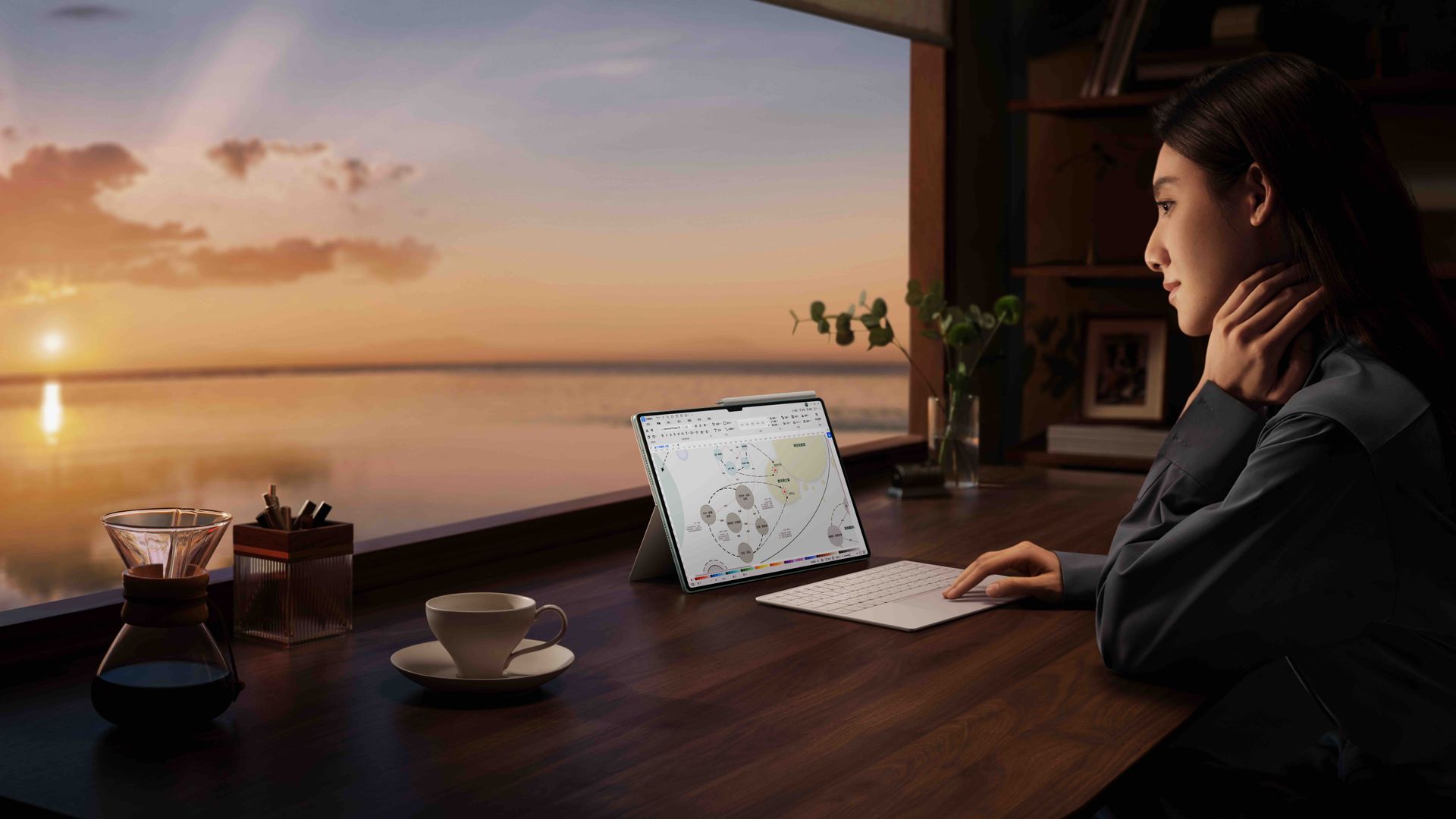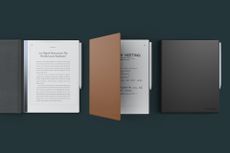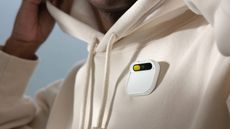Huawei’s new MatePad Pro 13.2-inch tablet has big-screen credentials
The feature-packed Huawei MatePad Pro 13.2-inch is a new hero for curating, creating and reshaping beautiful content, wherever you are

In partnership with Huawei
Speed, quality and portability come together in Huawei MatePad Pro 13.2-inch, a big-screen tablet that’s designed for power users who want every option at their fingertips. The MatePad Pro is the latest in the company’s series of increasingly sophisticated tablet computers; ultra-thin (5.5mm), extremely light (just 580 grams) and yet packed with high-quality speakers, a maximum of 12GB of RAM and 512GB of internal storage, it’ll become your perfect go-anywhere creative companion, an effortlessly simple tool to have at hand.

Available in either Golden Black or a unique soft Green, the MatePad Pro 13.2-inch is compatible with a wide range of new and familiar apps, from media streaming to picture and video editing, along with social media, games, connectivity, productivity and much, much more.

The tablet’s stand-out feature is its 2880 x 1920-pixel HD resolution 13.2-inch screen, which comes with full integration with Huawei’s third-generation M-Pencil. This is what really brings this tablet to life. The drawing and writing capabilities of the Pro are top notch, with a smooth screen that allows the M-Pencil to glide across the surface. The newest iteration of the M-Pencil has over 10,000 pressure sensing levels and ultra-low latency, allowing you to sketch naturally and freely on the edge-to-edge OLED screen. The screen’s high refresh rate, up to 144Hz, has earned the tablet the Global Eye Care 3.0 mark from TÜV Rheinland, industry-leading certification specialists.
The graphics are also boosted by the MatePad Pro’s Natural Light Sensing Display, which instantly compensates for changes in ambient light, along with with pro-level colour accuracy. Coupled with the M-Pencil’s pixel-perfect brush placement, and in drawing apps like Mojing Paint and Sketchbook, as well as sophisticated modelling apps like Nomad Sculpt, are a joy to use. Other essential modern tools, including Capcut and Filmora for video editing and effects, and image editing software like Adobe’s industry-leading Lightroom and Snapseed make light work of content creation.

The latter illustrates the tablet’s raw processing power, with a silky-smooth interface and ability to switch instantly between apps. When not in use, the M-Pencil magnetically attaches to the top of the tablet where it’ll also be wirelessly charged.
The MatePad Pro looks as good as it feels, a lightweight design that’s expressed through the slender casing. The optional Smart Magnetic Keyboard doubles up as a case and stand, and can be detached to create a compact, portable audio-visual workstation, and a hugely competent media player, with excellent immersive sound quality from the six speakers.

The battery provides up to 12 hours of onboard video playback time and the tablet also supports Huawei’s 88W SuperPower wired charger, which needs just ten minutes to add a couple of hours of playback time. Huawei has managed to package an impressive amount of technology into such a slender device.
Thanks to the company’s programme of establishing ‘aesthetics centres’ in Europe, including in France, Italy and the UK, to track trends in design and aesthetics, its industrial designers and software engineers are able to provide a consistently engaging and up-to-date experience. Curating, creating and reshaping beautiful content is now possible, wherever you are.
Wallpaper* Newsletter
Receive our daily digest of inspiration, escapism and design stories from around the world direct to your inbox
Jonathan Bell has written for Wallpaper* magazine since 1999, covering everything from architecture and transport design to books, tech and graphic design. He is now the magazine’s Transport and Technology Editor. Jonathan has written and edited 15 books, including Concept Car Design, 21st Century House, and The New Modern House. He is also the host of Wallpaper’s first podcast.
-
 Gallery Fumi makes LA debut with works from Max Lamb, Jeremy Anderson and more
Gallery Fumi makes LA debut with works from Max Lamb, Jeremy Anderson and moreFumi LA is the London design gallery’s takeover of Sized Studio, marking its first major US show (until 9 March 2024)
By Tianna Williams Published
-
 Brazil’s Casa Subtração contrasts dramatic concrete brutalism with openness
Brazil’s Casa Subtração contrasts dramatic concrete brutalism with opennessCasa Subtração by FGMF is defined by brutalist concrete and sharp angles that contrast with the green Brazilian landscape
By Ellie Stathaki Published
-
 Level up at the The Residence, Claridge’s new André Fu-designed penthouse
Level up at the The Residence, Claridge’s new André Fu-designed penthouseClaridge’s The Residence is a new purpose-built two-tier glasshouse overlooking London’s skyline
By Lauren Ho Published
-
 CES 2024: truly all the tech you need and then some
CES 2024: truly all the tech you need and then someThe best tech of CES 2024, from next-level laptops to mindful mirrors, audacious audio and more innovation than you can shake a smart bot at
By Jonathan Bell Published
-
 Cassette players for analogue audio lovers as we explore tapes’ slow and steady revival
Cassette players for analogue audio lovers as we explore tapes’ slow and steady revivalBrand-new cassette players, refurbished classics and the best second-hand sources to experience analogue audio in 2024
By Jonathan Bell Published
-
 Quirky tech for 2024, from robotic space dogs to extreme speakers
Quirky tech for 2024, from robotic space dogs to extreme speakersOur pick of quirky tech for the year ahead embraces ten more eccentric products, partnerships and conceptual dreams
By Jonathan Bell Published
-
 Year in review: top 10 gadgets of 2023, as selected by Wallpaper’s Jonathan Bell
Year in review: top 10 gadgets of 2023, as selected by Wallpaper’s Jonathan BellOur top 10 gadgets of 2023 are, by definition, items we do not need. Yet, from an e-ink tablet to a flip phone and a coffee maker, they are things we couldn’t help but admire
By Jonathan Bell Published
-
 Wallpaper* gift guide: shopping with technology editor Jonathan Bell
Wallpaper* gift guide: shopping with technology editor Jonathan BellThe best tech gifts, from gaming on the go to a Japanese record player, and the odd creative curveball
By Jonathan Bell Published
-
 Three new record players offer fresh ways to experience old vinyl
Three new record players offer fresh ways to experience old vinylEach of these recently released record players makes it easy to bring the warmth of vinyl back into your daily listening habits
By Jonathan Bell Published
-
 Humane’s Ai Pin is a wearable personal assistant, powered by artificial intelligence
Humane’s Ai Pin is a wearable personal assistant, powered by artificial intelligenceThe launch of the Humane Ai Pin sees invisible computing and ubiquitous AI take a big step towards the mainstream
By Jonathan Bell Published
-
 Google Pixel Watch 2 wants to look after you
Google Pixel Watch 2 wants to look after youThe Google Pixel Watch 2 harnesses the power and potential of FitBit, which the company acquired in 2022, for both personal wellness and safety
By Pei-Ru Keh Published










